Developing nations contribute less climate emissions and yet face the harshest impacts from climate change. Rapidly urbanizing cities in developing are more vulnerable to climate change and are the least able to respond to its effects. They are hampered by limited financial, human and technical resources as well as weak institutions and governance structures relating to disaster mitigation and preparedness. At the same time, since these cities contribute very little to global warming, their suffering is disproportionate. Historically, cities and settlements grew along coastlines and valleys due to the strategic benefits such as ease of trade. Cities, especially those in warm climates or low-lying coastal areas, face existential threats due to the risks and impacts of climate change and natural hazards, such as increased extreme heat events and pervasive flooding.
According to the International Panel on Climate Change, sea levels are set to rise between 18-59 cm by the end of the century coupled with rising global temperatures . This poses a great challenge for low-lying coastal areas as they risk, at the least, coastal erosion and seepage of salt water into underground coastal waters and at the extreme end, loss of lives and livelihoods as a result of natural disasters such as floods and extreme weather events . In 2015 Chennai, the fourth major metropolitan city of India with a population of five (5) million people, experienced unusually high precipitation which resulted in extreme flooding and associated destruction. It was observed that the sea surface temperatures were anomalously high in the Southern Bay of Bengal impacting the intensity of the Chennai rainfall .
Flooding in the East and West Coast due to heavy rains, Africa, Internet sources
Furthermore, the effects of climate change in developing nations can exacerbate existing urban challenges and make it more difficult to tackle the persistent issues that cities already face, such as poverty, inequality, infrastructure deficits and housing, among others. These challenges could make it difficult for developing nations to achieve certain SDGs, especially those relating to poverty, hunger, health, water and sanitation, and ecosystems. The long-term effects of climate change could also combine with the short-term impact of the COVID-19 pandemic to further reverse global gains by pushing hundreds of million people into poverty .
While it is acknowledged that developing countries have more complex challenges to address in tackling climate change than their developed counterparts, there are several efforts in the right direction. eThekwini Municipality in South Africa has risen to the occasion by developing a comprehensive Climate Resilience Implementation Plan for Spatial Planning (CRISP). In this plan, climate change response is given due consideration in terms of budgeting thus increasing the resilience factor of the municipality. The Government of Chile, through the Metropolitan Climate Change Platform, has supported two municipalities to develop climate-proof urban development concepts. Integrating climate change response in urban planning is a key step in climate-proofing cities in developing contexts .
Moving forward, it will be important to target major contributing sectors to climate change. The transport sector in Africa remains the dominant source of climate pollutants. Not only does air pollution pose a climate threat in Africa, but also has major public health and economic implications. The economic cost of ambient air pollution in Africa is approximately $215 billion recorded in healthcare costs, sick leave days, reduced economic output, loss of young manpower among other parameters . Actors will need to shift their focus from planning for personal cars to planning for lower carbon mobility through promoting public transport, non-motorized transport and mobility powered by renewable energy including electric mobility thus reducing the sector’s reliance on fossil fuels. It will also be essential to lobby policy makers and politicians to advocate for an inclusive urban planning targeting appropriate policies. that promote sustainable urban mobility, behavioural changes, adaptation and mitigating climate change. There is a need to increase efforts in integrating modern technology in data collection to aid in evidence-based decision making.
References:
GIZ. (2019). Cities fit for Climate Change: A Sourcebook for Climate-proof Urban Development. Berlin: GIZ on behalf of the Federal Ministry for the Environment, Nature Conservation and Nuclear Safety.
UN-Habitat. (2020). The Value of Sustainable Urbanization. Nairobi: United Nations Human Settlements Programme.
IPCC. (2021). Climate Change 2021 The Physical Science Basis. Switzerland: Intergovernmental Panel on Climate Change.
Boyaj, A., Ashok, K., Ghosh, S., Devanand, A., & Dandu, G. (2018). The Chennai extreme rainfall event in 2015: The Bay of Bengal connection. Climate Dynamics (CLIM DYNAM), 2307–2322.
GIZ. (2019). Cities Fit for Climate Change: A sourcebook for climate+proof urban development. Bonn: Deutsche Gesellschaft für Internationale Zusammenarbeit (GIZ) .
OECD. (2016). The Cost of Air Pollution in Africa. OECD Development Centre.

